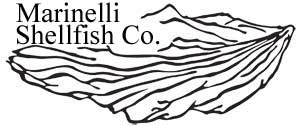Oyster, Mussel, Clam and Finfish Handling Information
Marinelli Shellfish Company
Oyster Handling Information
For longest shelf life, live oysters should be stored in a cold (35-40F, 1-4C), dark place and not disturbed. The box they arrive in should be drained of standing water by making holes in the bottom, or they can be transferred to a similar type of storage container, and then a damp towel should be placed on top of the oysters to keep them moist. Never let them sit in water.For restaurant and retail applications there are additional steps that will help extend shelf life. Only take out the amount of oysters needed for service, as they do not like going from cold to warm and then back to cold again. Always try to maintain a cold serving temperature. Use the oysters that are left over from evening service first and do not mix with new inventory. They are live animals until they are served and must be kept cold during storage, preparation, and service. Serve on a bed of crushed ice.
Properly stored, oysters have a shelf life of about 10 days from harvest with minimum mortality. Utilizing these techniques it is not uncommon to get even more, sometimes exceeding two weeks.
Mussel Handling Information
Live mussels are unique in that they enjoy ice, but they should not be allowed to sit in standing water. The box they arrive in should be drained of standing water by making holes in the bottom, or they can be transferred to a similar type of storage container, and then the mussels should be covered with ice. Make sure the container they are in is able to drain so the mussels do not sit in water.For restaurant and retail applications there are additional steps that will help extend shelf life. Place the appropriate quantity of mussels needed for service in ice water. Those that do not close, even slightly, should be discarded. De-beard the mussels that remain, place them in a container that will drain, and cover them again with ice to keep them cold during service. Use the mussels that are left over from evening service first and do not mix with new inventory.
Mussels tend to open when left alone, but only those that smell or those that will not close slightly when handled need to be discarded. They do not have to close completely, but they should not have a strong smell. As long as they close slightly and do not smell, they are still alive and can be served.
Clam Handling Information
For longest shelf life, live clams should be stored in a cold (35-40F, 1-4C), dark place and not disturbed. The box they arrive in should be drained of standing water by making holes in the bottom, or they can be transferred to a similar type of storage container, and then a damp towel should be placed on top of the clams to keep them moist. Never let them sit in water.For restaurant and retail applications there are additional steps that will help extend shelf life. Only take out the amount of clams needed for service, as they do not like going from cold to warm and then back to cold again. Use the clams that are left over from evening service first and do not mix with new inventory.
Finfish Handling Information
To maintain the best meat condition when handling h&g, dressed, or whole fish, do so delicately. Lift by both the head and tail so as not to separate the flesh while it is still on the bone. For longest shelf life, bury fresh finfish in crushed or flake ice and keep it there. The colder the better, so salt ice is best. The tote, box, or tray they are stored in must be allowed to drain so the meat does not sit in standing water. Pack the belly cavity of h&g or dressed fish with ice as well. Careful handling using these simple techniques will extend shelf life and preserve the meat’s texture.

